Page 186 of 412
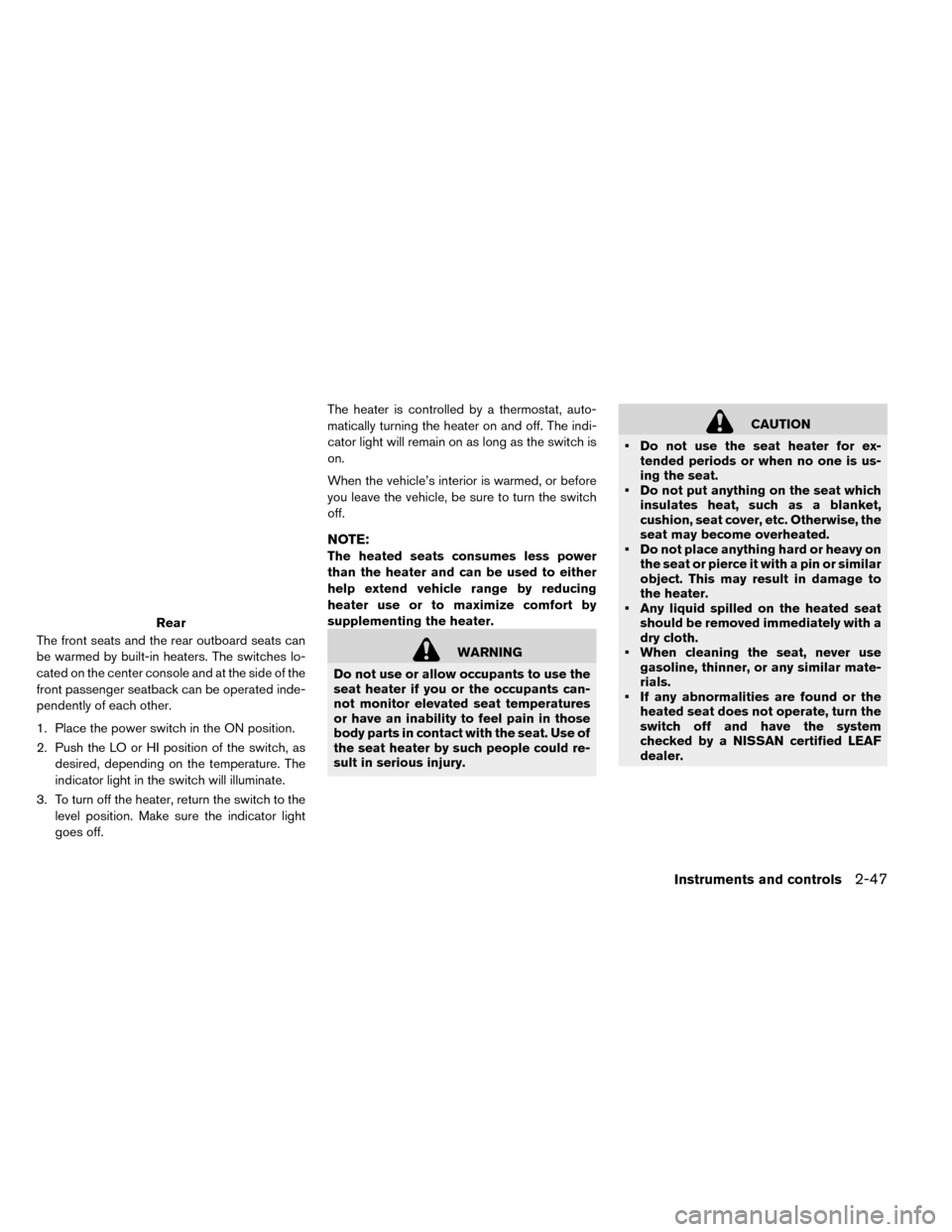
The front seats and the rear outboard seats can
be warmed by built-in heaters. The switches lo-
cated on the center console and at the side of the
front passenger seatback can be operated inde-
pendently of each other.
1. Place the power switch in the ON position.
2. Push the LO or HI position of the switch, asdesired, depending on the temperature. The
indicator light in the switch will illuminate.
3. To turn off the heater, return the switch to the level position. Make sure the indicator light
goes off. The heater is controlled by a thermostat, auto-
matically turning the heater on and off. The indi-
cator light will remain on as long as the switch is
on.
When the vehicle’s interior is warmed, or before
you leave the vehicle, be sure to turn the switch
off.
NOTE:
The heated seats consumes less power
than the heater and can be used to either
help extend vehicle range by reducing
heater use or to maximize comfort by
supplementing the heater.
WARNING
Do not use or allow occupants to use the
seat heater if you or the occupants can-
not monitor elevated seat temperatures
or have an inability to feel pain in those
body parts in contact with the seat. Use of
the seat heater by such people could re-
sult in serious injury.
CAUTION
• Do not use the seat heater for ex- tended periods or when no one is us-
ing the seat.
• Do not put anything on the seat which insulates heat, such as a blanket,
cushion, seat cover, etc. Otherwise, the
seat may become overheated.
• Do not place anything hard or heavy on the seat or pierce it with a pin or similar
object. This may result in damage to
the heater.
• Any liquid spilled on the heated seat should be removed immediately with a
dry cloth.
• When cleaning the seat, never use gasoline, thinner, or any similar mate-
rials.
• If any abnormalities are found or the heated seat does not operate, turn the
switch off and have the system
checked by a NISSAN certified LEAF
dealer.
Rear
Instruments and controls2-47
Page 190 of 412
Soft bottle holders
CAUTION
• Do not use the bottle holder for any other objects that could be thrown
about in the vehicle and possibly injure
people during sudden braking or an
accident.
• Do not use the bottle holder for open liquid containers.
SEATBACK POCKET
The seatback pocket is located on the back of the
passenger’s seat. The pocket can be used to
store maps.
SUNGLASSES HOLDER
To open the sunglasses holder, push and release.
Only store one pair of sunglasses in the holder.
WARNING
Keep the sunglasses holder closed while
driving to prevent an accident.
Instruments and controls2-51
Page 191 of 412
CAUTION
• Do not use for anything other than sunglasses.
• Do not leave sunglasses in the sun- glasses holder while parking in direct
sunlight. The heat may damage the
sunglasses.
GLOVE BOX
To open the glove box, pull the handle.
To close, push the lid in until the lock latches.
WARNING
Keep the glove box lid closed while driv-
ing to prevent injury in case of an acci-
dent or a sudden stop.
CONSOLE BOX
To open the console box, push up the knob�A
and pull up the lid. To close, push the lid down
until it is latched.
2-52Instruments and controls
Page 192 of 412
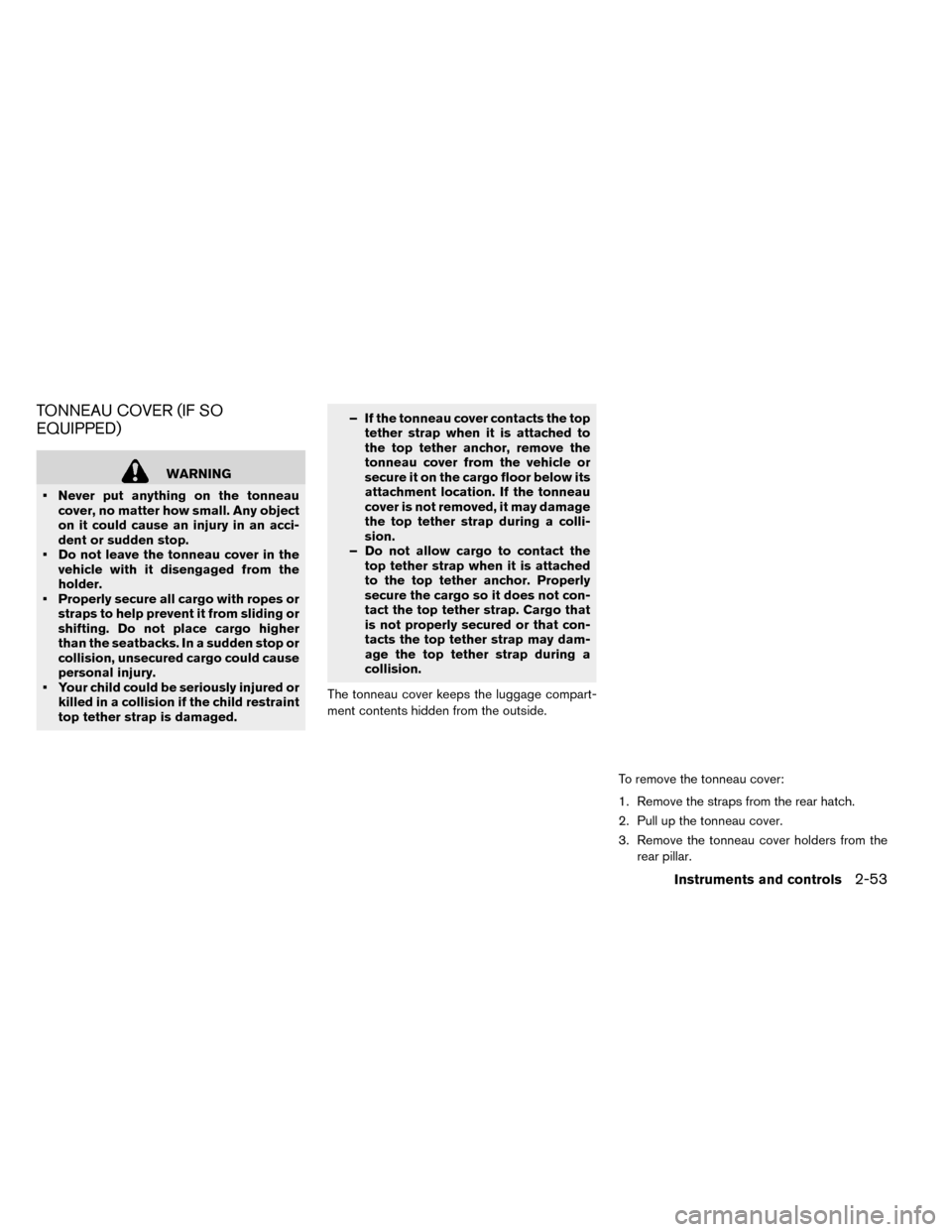
TONNEAU COVER (IF SO
EQUIPPED)
WARNING
• Never put anything on the tonneau cover, no matter how small. Any object
on it could cause an injury in an acci-
dent or sudden stop.
• Do not leave the tonneau cover in the vehicle with it disengaged from the
holder.
• Properly secure all cargo with ropes or straps to help prevent it from sliding or
shifting. Do not place cargo higher
than the seatbacks. In a sudden stop or
collision, unsecured cargo could cause
personal injury.
• Your child could be seriously injured or killed in a collision if the child restraint
top tether strap is damaged. – If the tonneau cover contacts the top
tether strap when it is attached to
the top tether anchor, remove the
tonneau cover from the vehicle or
secure it on the cargo floor below its
attachment location. If the tonneau
cover is not removed, it may damage
the top tether strap during a colli-
sion.
– Do not allow cargo to contact the top tether strap when it is attached
to the top tether anchor. Properly
secure the cargo so it does not con-
tact the top tether strap. Cargo that
is not properly secured or that con-
tacts the top tether strap may dam-
age the top tether strap during a
collision.
The tonneau cover keeps the luggage compart-
ment contents hidden from the outside.
To remove the tonneau cover:
1. Remove the straps from the rear hatch.
2. Pull up the tonneau cover.
3. Remove the tonneau cover holders from therear pillar.
Instruments and controls2-53
Page 194 of 412
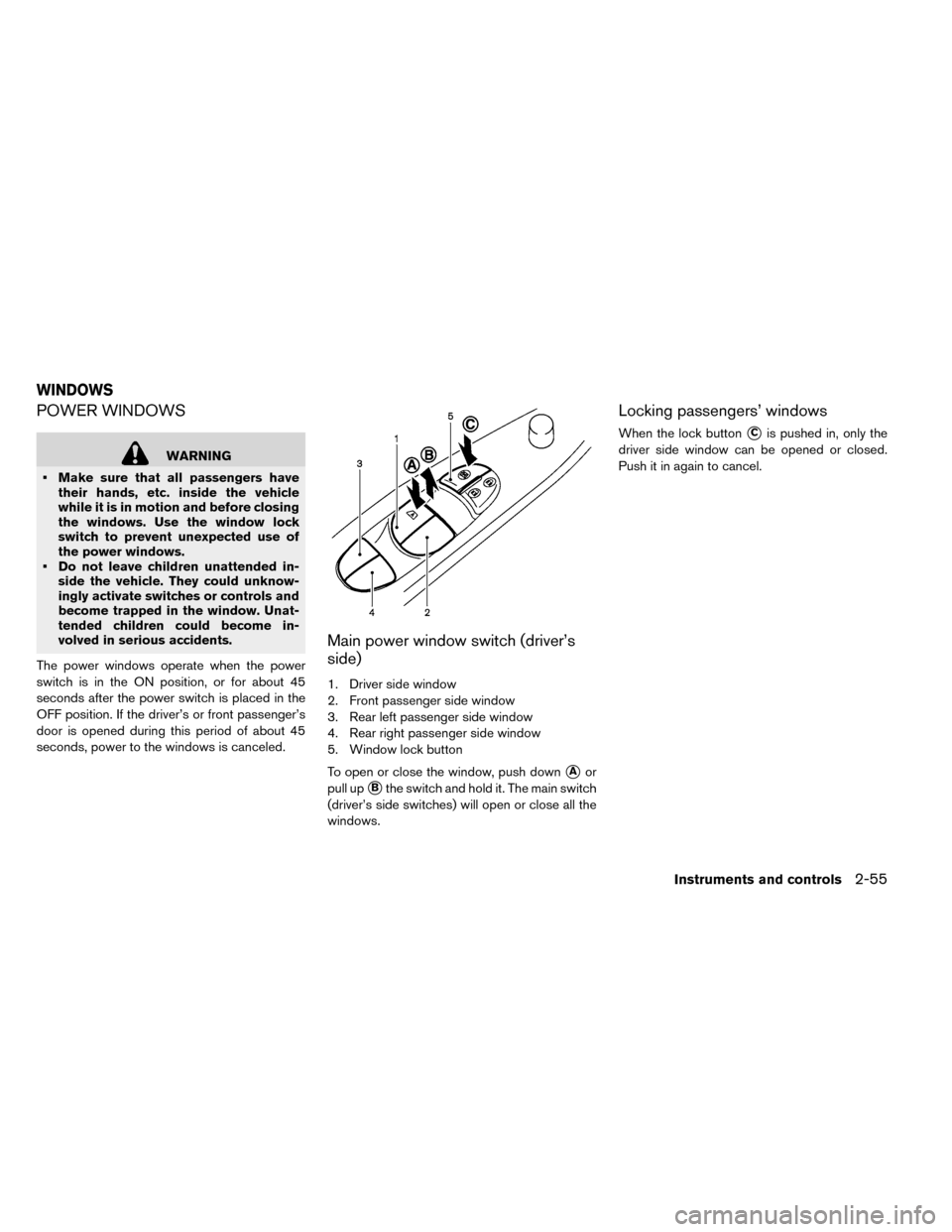
POWER WINDOWS
WARNING
• Make sure that all passengers have their hands, etc. inside the vehicle
while it is in motion and before closing
the windows. Use the window lock
switch to prevent unexpected use of
the power windows.
• Do not leave children unattended in- side the vehicle. They could unknow-
ingly activate switches or controls and
become trapped in the window. Unat-
tended children could become in-
volved in serious accidents.
The power windows operate when the power
switch is in the ON position, or for about 45
seconds after the power switch is placed in the
OFF position. If the driver’s or front passenger’s
door is opened during this period of about 45
seconds, power to the windows is canceled.
Main power window switch (driver’s
side)
1. Driver side window
2. Front passenger side window
3. Rear left passenger side window
4. Rear right passenger side window
5. Window lock button
To open or close the window, push down
�Aor
pull up
�Bthe switch and hold it. The main switch
(driver’s side switches) will open or close all the
windows.
Locking passengers’ windows
When the lock button�Cis pushed in, only the
driver side window can be opened or closed.
Push it in again to cancel.
WINDOWS
Instruments and controls2-55
Page 195 of 412
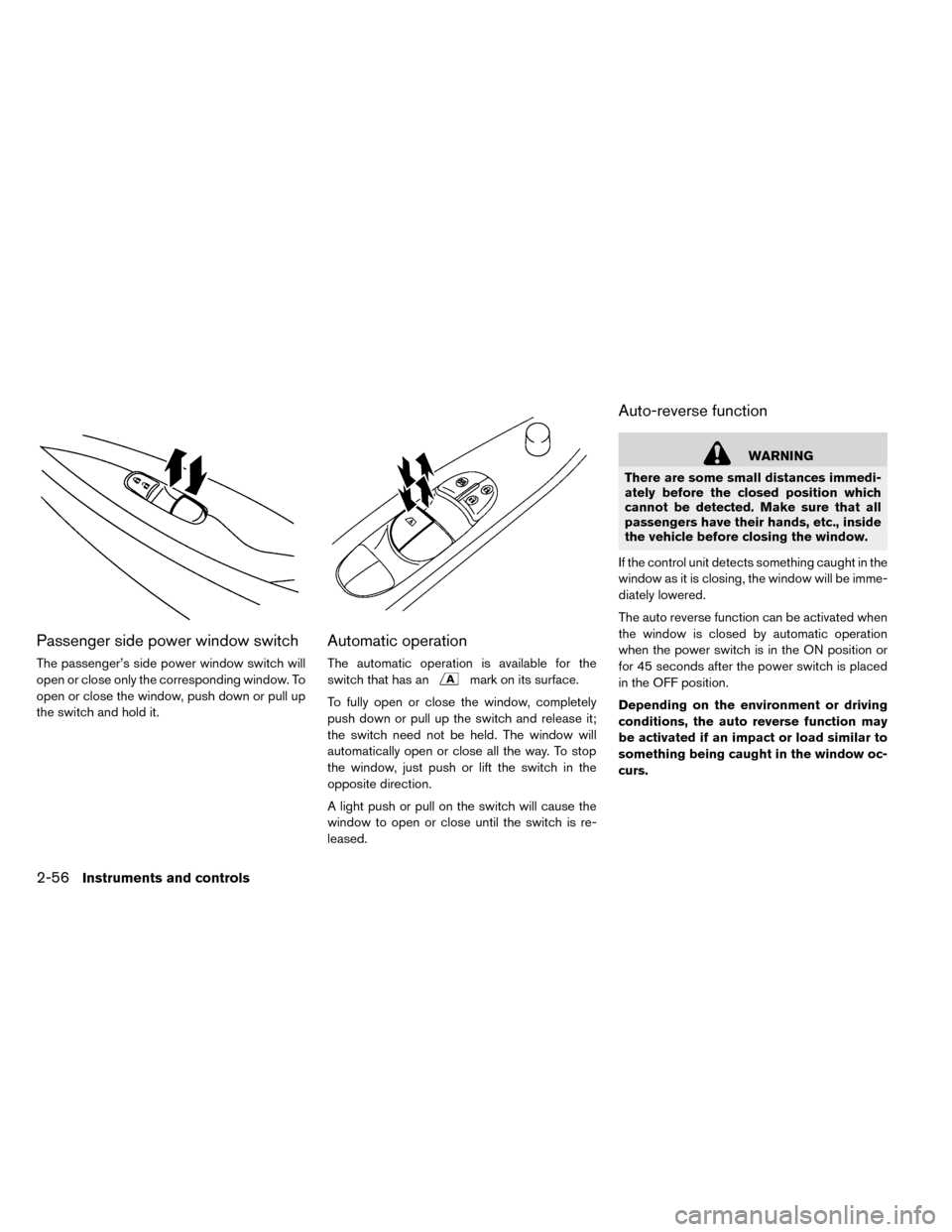
Passenger side power window switch
The passenger’s side power window switch will
open or close only the corresponding window. To
open or close the window, push down or pull up
the switch and hold it.
Automatic operation
The automatic operation is available for the
switch that has an
mark on its surface.
To fully open or close the window, completely
push down or pull up the switch and release it;
the switch need not be held. The window will
automatically open or close all the way. To stop
the window, just push or lift the switch in the
opposite direction.
A light push or pull on the switch will cause the
window to open or close until the switch is re-
leased.
Auto-reverse function
WARNING
There are some small distances immedi-
ately before the closed position which
cannot be detected. Make sure that all
passengers have their hands, etc., inside
the vehicle before closing the window.
If the control unit detects something caught in the
window as it is closing, the window will be imme-
diately lowered.
The auto reverse function can be activated when
the window is closed by automatic operation
when the power switch is in the ON position or
for 45 seconds after the power switch is placed
in the OFF position.
Depending on the environment or driving
conditions, the auto reverse function may
be activated if an impact or load similar to
something being caught in the window oc-
curs.
2-56Instruments and controls
Page 198 of 412
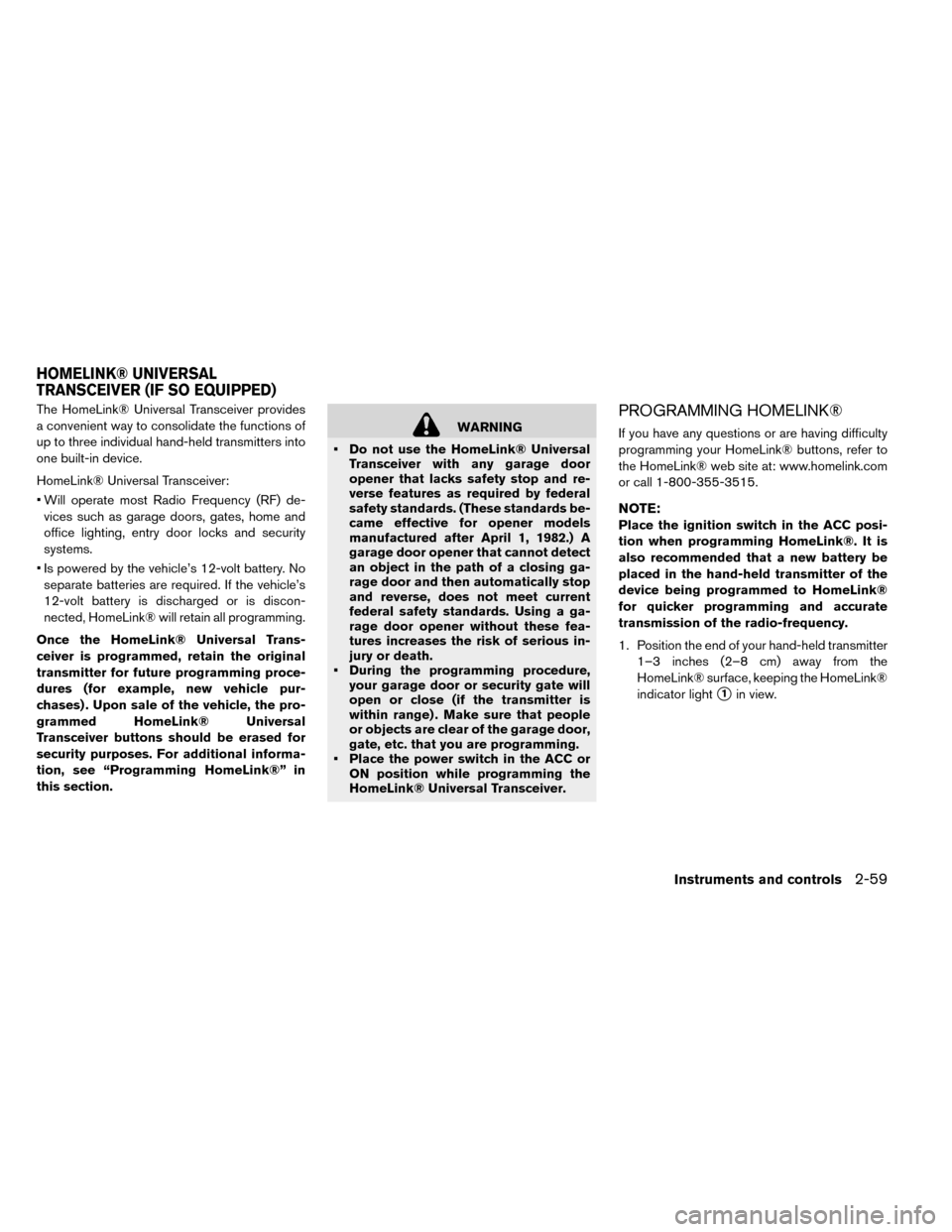
The HomeLink® Universal Transceiver provides
a convenient way to consolidate the functions of
up to three individual hand-held transmitters into
one built-in device.
HomeLink® Universal Transceiver:
• Will operate most Radio Frequency (RF) de-vices such as garage doors, gates, home and
office lighting, entry door locks and security
systems.
• Is powered by the vehicle’s 12-volt battery. No separate batteries are required. If the vehicle’s
12-volt battery is discharged or is discon-
nected, HomeLink® will retain all programming.
Once the HomeLink® Universal Trans-
ceiver is programmed, retain the original
transmitter for future programming proce-
dures (for example, new vehicle pur-
chases) . Upon sale of the vehicle, the pro-
grammed HomeLink® Universal
Transceiver buttons should be erased for
security purposes. For additional informa-
tion, see “Programming HomeLink®” in
this section.
WARNING
• Do not use the HomeLink® Universal Transceiver with any garage door
opener that lacks safety stop and re-
verse features as required by federal
safety standards. (These standards be-
came effective for opener models
manufactured after April 1, 1982.) A
garage door opener that cannot detect
an object in the path of a closing ga-
rage door and then automatically stop
and reverse, does not meet current
federal safety standards. Using a ga-
rage door opener without these fea-
tures increases the risk of serious in-
jury or death.
• During the programming procedure, your garage door or security gate will
open or close (if the transmitter is
within range) . Make sure that people
or objects are clear of the garage door,
gate, etc. that you are programming.
• Place the power switch in the ACC or ON position while programming the
HomeLink® Universal Transceiver.
PROGRAMMING HOMELINK®
If you have any questions or are having difficulty
programming your HomeLink® buttons, refer to
the HomeLink® web site at: www.homelink.com
or call 1-800-355-3515.
NOTE:
Place the ignition switch in the ACC posi-
tion when programming HomeLink®. It is
also recommended that a new battery be
placed in the hand-held transmitter of the
device being programmed to HomeLink®
for quicker programming and accurate
transmission of the radio-frequency.
1. Position the end of your hand-held transmitter
1–3 inches (2–8 cm) away from the
HomeLink® surface, keeping the HomeLink®
indicator light
�1in view.
HOMELINK® UNIVERSAL
TRANSCEIVER (IF SO EQUIPPED)
Instruments and controls2-59
Page 202 of 412
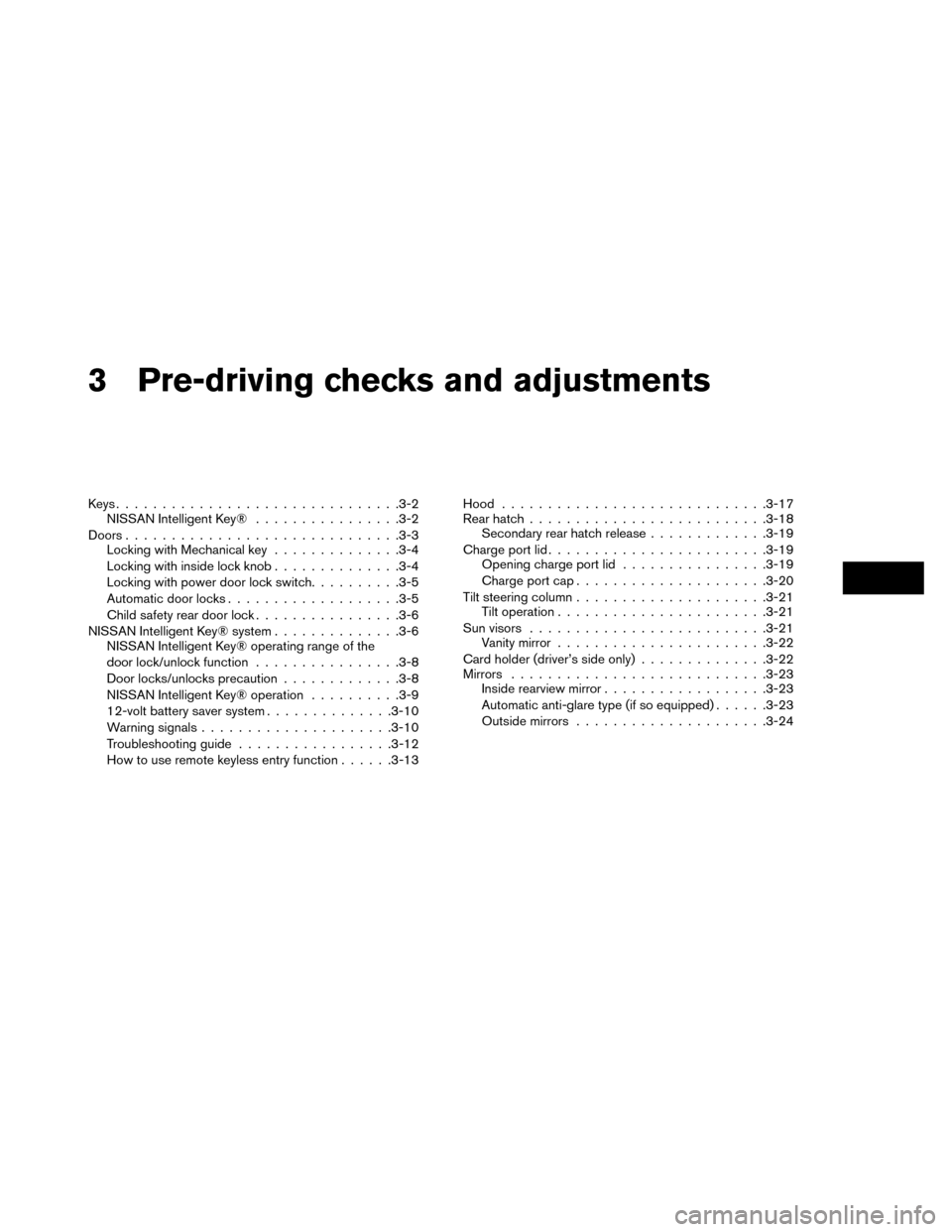
3 Pre-driving checks and adjustments
Keys...............................3-2
NISSAN Intelligent Key® ................3-2
Doors ............................. .3-3
Locking with Mechanical key ..............3-4
Locking with inside lock knob ..............3-4
Locking with power door lock switch..........3-5
Automatic door locks .................. .3-5
Child safety rear door lock ................3-6
NISSAN Intelligent Key® system ..............3-6
NISSAN Intelligent Key® operating range of the
door lock/unlock function ................3-8
Door locks/unlocks precaution .............3-8
NISSAN Intelligent Key® operation ..........3-9
12-volt battery saver system ..............3-10
Warning signals .................... .3-10
Troubleshooting guide ................ .3-12
How to use remote keyless entry function ......3-13Hood
............................ .3-17
Rear hatch ......................... .3-18
Secondary rear hatch release .............3-19
Charge port lid ....................... .3-19
Opening charge port lid ................3-19
Charge port cap .................... .3-20
Tilt steering column .................... .3-21
Tilt operation ...................... .3-21
Sun visors ......................... .3-21
Vanity mirror ...................... .3-22
Card holder (driver’s side only) ..............3-22
Mirrors ........................... .3-23
Inside rearview mirror ................. .3-23
Automatic anti-glare type (if so equipped) ......3-23
Outside mirrors .................... .3-24